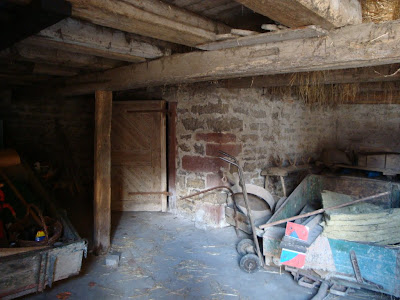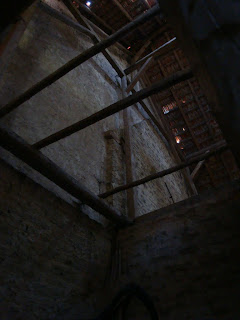 |
| The grand entrance. |
The last barn post had a little about how the barn developed over the years. What I hadn't noticed, till recently, is the year 1905 above the main door. I doubt very much that the piece of plaster the date is on comes from 1905, but it may be a clue as to when the original, simple structure was built, 65 years after the house. Doesn't seem right, but as the house itself housed animals, it could well be.
It's difficult to describe the inside of the barn without referencing how it developed, so I won't bother going into detail here. Just read back to
the previous post if a year is mentioned here. Instead, we'll take a brief photo tour, with descriptions.
The main door is 3 metres high, so plenty of room for getting a tractor and trailer in. The lower 3m is stone, with the rest being half-timbered, with 14x14cm oak beams, brick and clay-based plaster. Luckily there's a small, person-size door built into the main door, so it doesn't have to be opened every time.
Upon entering, on the left, there is a small cellar that is not indicated on any of the plans, so we don't know when it was constructed. This area has a low ceiling, with large beams supporting a hay/straw storage area above.
 |
| First small cellar on north side (left as entering). |
 |
| Door to second cellar. |
Further to the back is into the area that was
extended in 1922, and
again in 1947. The door in the photo to the right leads to the cellar in the northeast corner. The wall immediately to the left of the doorway is the eastern wall of the original small barn, so it was quite a modification, removing several metres of the original back wall to extend the main hall. There's a storage area immediately above the cellar, in a fairly awkward arrangement, presumably as there was originally a low, lean-to roof over it until the later extension. This means the floor here is not on a level with the other "floors", as represented by the beams running across the top right of the photo.
 |
| Inside the cellar. |
 |
| Upper levels, looking north. |
The two phases of construction can be clearly seen inside this cellar, with slightly different finishes and aging on the left and right sections of the wall opposite the door (the left side of the photo above). The window in this wall was originally a chute, as was the one on the right after 1947, however this has since been covered with earth on the outside (it can be seen that water seeps in if it's wet outside). This will be cleared away and the chutes will be turned into windows to let a little more light in.
Staying on the left side as you enter, above these cellars is large, open space. I'm still estimating, but it must be more than 13 metres from the ground to the apex. The space is crossed with hefty 26x26cm oak beams. I'm pretty sure another floored level or two could be easily accommodated.
 |
| Upper levels, looking east from above the first level. |
 |
| Southern gable of main barn |
To the right of the main hall is more or less open space. Once interesting feature is that the gable from the previously adjoining neighbours barn is still there. We know this was from the neighbours barn as the iron anchors that used to tie the gable to the oak cross-beams are still there, hanging useless. The black bar, just below and to the right of centre, would have been in the external wall, from the perspective of the neighbour.
The beams running across the empty space would have held up hay, keeping it aired, and there are boards lying around to be used as temporary flooring.
In the centre of the main hall is what could be considered
a shaft, across which no timbers cross. A winch used to operate a hoist here, to lift materials to the higher levels. We'll come back to the winch room in another post.
The extension to the south, which was
built in 1960, is a much simpler affair, being a lean-to in form, and consisting of an open plan feeding hall, with hatches along the southern wall allowing feed to be popped directly into the troughs on the other side. Entry to the hall is via a pair of large, sliding doors. To the left, there are two openings leading into the main barn.
 |
| The feeding hall. |
The other side was then, of course, all stalls, in a kind of building within a building, as can be seen on the right of the photo above. There are lots of south-facing windows in the stalls area, so it's nice and bright. The posts are not supporting, so we'll probably remove them to open this up a bit and use it as a workshop.
 |
| The stalls. |


